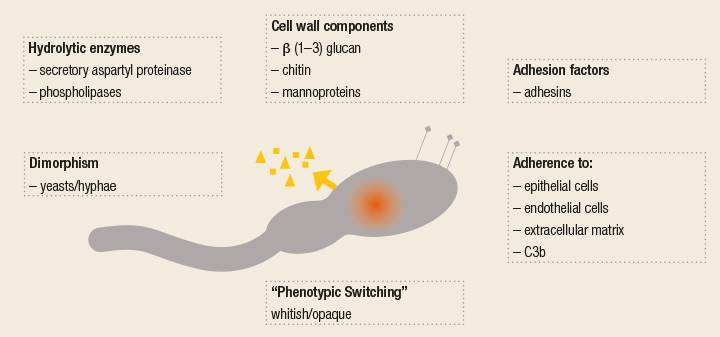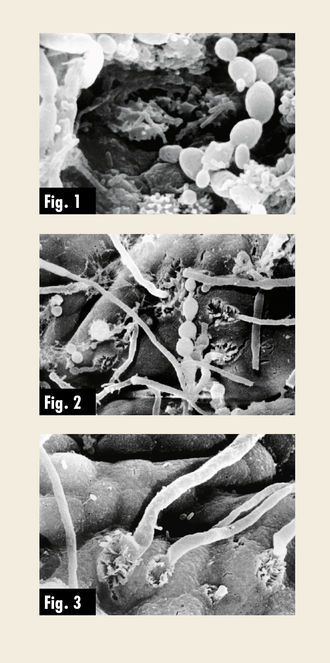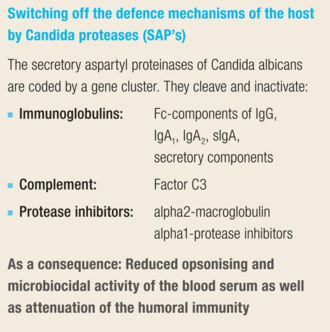Pathogenicity characteristics of Candida
Yeasts, which cause mycotic infections, are mostly representatives of the genus Candida, in particular Candida albicans, and also to an increasing extent Candida glabrata, Candida tropicalis and Candida krusei. Yeasts are so-called facultative pathogenic organisms, i.e. the emergence of a disease state depends on both the pathogenic characteristics of the yeasts, as well as the immune status of the host.
Variable spectrum of virulence factors
Yeasts exhibit a varying spectrum of virulence factors. Whereas certain components of the cell wall (chitin, glucan) are of importance for the integrity of the Candida cell, the mannoproteins of the cell wall as well as the fimbria are said to have a role as adhesins.
These adhesins can are able to bind to receptors of the host cell and thus initiate the colonisation of Candida within the host organism. The so-called integrins have been described more recently as new adhesion factors. With their help, specific interaction with epithelial cells, endothelial cells, fibrinogen, fibronectin and laminin (all components of the extracellular matrix), as well as with the C3b molecules of the complement system is possible.

SAPs specifically disable the immune function
In addition to the adhesins and integrins, Candida forms enzymes, which are of importance for the occurrence of infection. These include firstly the secretory aspartyl proteinases (SAPs), which have the best activity in the acid pH range but are still active up to pH 7. Candida albicans has at least ten slightly different proteinases, which are coded by ten different genes. Thanks to the proteinases, the yeasts are able to switch off specific defence functions of the host.
Genetic adaptation to environmental factors
The individual proteinase genes are not expressed at the same time so that the activity of virulence factors can be modified by environmental factors. Thus, the SAP-2 gene is induced by the presence of proteins in the culture medium which serves as the sole nitrogen source for the yeast if low molecular weight sources of N are lacking. Further hydrolytic enzymes of Candida are the phospholipases, whose significance in the occurrence of infection has so far not been able to be clearly defined.
Adaptability of Candida albicans
Even under unfavourable environmental conditions, Candida albicans is extremely adaptable, thanks to its genetic flexibility:
- Specific chromosomal losses = Deletion of gene clusters (e.g. genes which mediate sensitivity towards toxic-acting/anti-mycotic substances)
- Specific chromosomal duplication = Propagation of gene clusters

Fig. 2: Morphological transition from the sprouting cell form to the more aggressive hypha form
Fig. 3: Invasion of hyphae in the cells of the intestinal epithelium
Dimorphism and "Phenotypic Switching"
Dimorphism and phenotypic switching are also important for the pathogenicity of yeasts. Whereas Candida normally grows as spherical yeast cells, hyphae play an important role in invasive diseases. The change of form ‘yeast/hypha’ (= dimorphism) is a prerequisite for the occurrence of infection.
Phenotypic switching is the ability of Candida albicans to adapt to altering environmental conditions, by changing its morphology and cell properties, such as e.g. its antigenic structure. This results in two different forms of colony: the white form (smooth, spherical, round cells) or the opaque form (flat, large cells with a changed lipid composition).
Dimorphism and switching are accompanied by a change in the biological activity of Candida. Hence, an increase in the expression of SAP 1 with a change of form ‘yeast/hypha’ with SAP 4 has been observed during switching. SAPs can inactivate factors of the immune defence system as well as cause damage to the host cells.
"Escape phenomenon"
The reversible changes to the cell surface (phenotypic switching), the change of physical shape and the possibility of the “invasion” of yeasts in macrophages are described as the “escape phenomenon”. Normally, yeasts are destroyed by macrophages and surface structures are presented as antigens of the specific immune defence (T/B-cells).
Under certain circumstances, however, yeast cells phagocytosed by macrophages may survive and "hide" in macrophages Secific immune defences are not activated. In this state, yeasts produces hyphae and can also escape the influence of antimycotics, which can lead to recurrence of the disease.

Adiclair Film-coated tablets international package insert to download
Adiclair Suspension international package insert to download
Adiclair Nystatin Mouth Gel international package insert to download
Adiclair Ointment international package insert to download
Adiclair Vaginal tablets international package insert to download
Adiclair Cream international package insert to download
